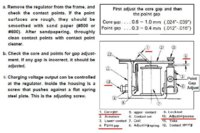The voltage on my 78 isn't where I'd like it to be at lower rpms.
It's charging 12volt at 2000rpms, but that's not enough to charge the battery and run my headlight.
I know I can adjust a few things on the mechanical regulator to up my voltage.
Inside Points: The points closest to the bike, which the actuator DOES NOT rest on most of the time.
Outside Points: The set of points to the outside of the bike, where the actuator appears to rest most of the time.
Spring tension: the screw closest to the resistor that appears to control tension of the actuator.
How do I adjust these to get 14volts?
Posted via Mobile
It's charging 12volt at 2000rpms, but that's not enough to charge the battery and run my headlight.
I know I can adjust a few things on the mechanical regulator to up my voltage.
Inside Points: The points closest to the bike, which the actuator DOES NOT rest on most of the time.
Outside Points: The set of points to the outside of the bike, where the actuator appears to rest most of the time.
Spring tension: the screw closest to the resistor that appears to control tension of the actuator.
How do I adjust these to get 14volts?
Posted via Mobile







